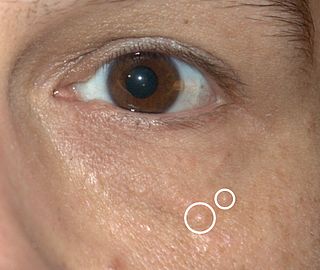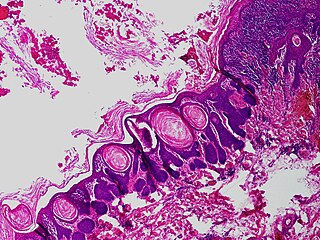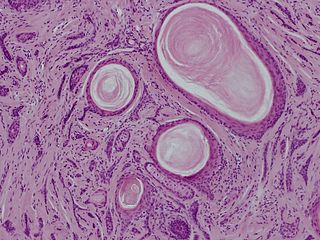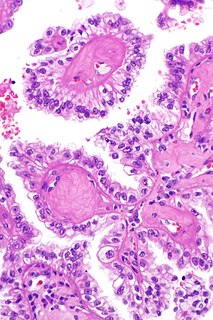| Giant solitary trichoepithelioma | |
|---|---|
| Specialty | Dermatology, oncology |
A giant solitary trichoepithelioma is a cutaneous condition characterized by a skin lesion that may be up to several centimeters in diameter. [1] :672
| Giant solitary trichoepithelioma | |
|---|---|
| Specialty | Dermatology, oncology |
A giant solitary trichoepithelioma is a cutaneous condition characterized by a skin lesion that may be up to several centimeters in diameter. [1] :672
A skin condition, also known as cutaneous condition, is any medical condition that affects the integumentary system—the organ system that encloses the body and includes skin, hair, nails, and related muscle and glands. The major function of this system is as a barrier against the external environment.

Nevus is a nonspecific medical term for a visible, circumscribed, chronic lesion of the skin or mucosa. The term originates from nævus, which is Latin for "birthmark"; however, a nevus can be either congenital or acquired. Common terms, including mole, birthmark, and beauty mark, are used to describe nevi, but these terms do not distinguish specific types of nevi from one another.

A papule is a circumscribed, solid elevation of skin with no visible fluid, varying in area from a pinhead to 1 cm. Papules can be brown, purple, pink or red in color, and can cluster into a papular rash. They may open when scratched and become infected and crusty. Larger non-blisterform elevated lesions may be termed nodules.

Syringomas are benign eccrine sweat duct tumors, typically found clustered on eyelids, although they may also be found in the armpits, abdomen, chest, neck, scalp or groin area including genitals in a symmetric pattern. They are skin-colored or yellowish firm, rounded bumps, 1–3 mm in diameter, and may be confused with xanthoma, milia, hidrocystoma, trichoepithelioma, and xanthelasma. They are more common in women and are most commonly found in middle-aged Asian women. While they can present at any time in life, they typically present during adolescence. They are usually not associated with any other symptoms although can sometimes cause itchiness or irritation.
Dermatophytids are fungus-free disseminated skin lesions resulting from induced sensitization in patients with ringworm infections.

Discoid lupus erythematosus is the most common type of chronic cutaneous lupus (CCLE), an autoimmune skin condition on the lupus erythematosus spectrum of illnesses. It presents with red, inflamed, coin-shaped patches of skin with a scaling and crusty appearance, most often on the scalp, cheeks, and ears. Hair loss may occur if the lesions are on the scalp. The lesions can then develop severe scarring, and the centre areas may appear lighter in color with a rim darker than the normal skin. These lesions can last for years without treatment.

Rombo syndrome is a very rare genetic disorder characterized mainly by atrophoderma vermiculatum of the face, multiple milia, telangiectases, acral erythema, peripheral vasodilation with cyanosis and a propensity to develop basal cell carcinomas. The lesions become visible in late childhood, began at ages 7 to 10 years and are most pronounced on the face, At that time a pronounced, somewhat cyanotic redness of the lips and hands was evident as well as moderate follicular atrophy of the skin on the cheeks. In adulthood, whitish-yellow, milia-like papules and telangiectatic vessels developed. The papules were present particularly on the cheeks and forehead, gradually becoming very conspicuous and dominating the clinical picture. Trichoepitheliomas were found in 1 case. In adults, the eyelashes and eyebrows were either missing or irregularly distributed with defective and maldirected growth. Basal cell carcinomas were a frequent complication. The skin atrophy was referred to as vermiculate atrophoderma. Basal cell carcinomas may develop around the age of 35. Histological observations during the early stage include irregularly distributed and atrophic hair follicles, milia, dilated dermal vessels, lack of elastin or elastin in clumps. After light irradiation a tendency to increased repair activity was observed both in epidermis and in the dermal fibroblasts. Histologic sections showed the dermis to be almost devoid of elastin in most areas with clumping of elastic material in other areas. The disorder had been transmitted through at least 4 generations with instances of male-to-male transmission.

Trichoepithelioma is a neoplasm of the adnexa of the skin. Its appearance is similar to basal cell carcinoma.

Porokeratosis is a specific disorder of keratinization that is characterized histologically by the presence of a cornoid lamella, a thin column of closely stacked, parakeratotic cells extending through the stratum corneum with a thin or absent granular layer.
Generalized trichoepitheliomas are characterized histologically by replacement of the hair follicles by trichoepithelioma-like epithelial proliferations associated with hyperplastic sebaceous glands.
Borderline leprosy is a cutaneous skin condition with numerous skin lesions that are red irregularly shaped plaques.

Spiradenoma, also spiroma or eccrine spiradenoma, is a cutaneous condition that is typically characterized, clinically, as a solitary, deep-seated dermal nodule of approximately one centimeter, occurring on the ventral surface of the body. Spiradenoma lesions are benign sudoriferous tumors, and have also been described as cystic epitheliomas of the sweat glands.

Trichofolliculoma is a cutaneous condition characterized by a benign, highly structured tumor of the pilosebaceous unit.
Multiple familial trichoepithelioma is a cutaneous condition characterized by multiple cystic and solid nodules appearing on the face.
A solitary trichoepithelioma is a cutaneous condition characterized by a firm dermal papules or nodules most commonly occurring on the face.

A desmoplastic trichoepithelioma is a cutaneous condition characterized by a solitary, firm skin lesion on the face.

Trichoblastomas are a cutaneous condition characterized by benign neoplasms of follicular germinative cells. Trichoblastic fibroma is a designation used to characterize small nodular trichoblastomas with conspicuous fibrocytic stroma, sometimes constituting over 50% of the lesion.

Reed’s syndrome is a rare inherited condition characterised by multiple cutaneous leiomyomas and, in women, uterine leiomyomas. It predisposes for renal cell cancer, an association denominated hereditary leiomyomatosis and renal cell cancer, and it is also associated with increased risk of uterine leiomyosarcoma. The syndrome is caused by a mutation in the fumarate hydratase gene, which leads to an accumulation of fumarate. The inheritance pattern is autosomal dominant.
Brooke–Fordyce syndrome is a condition characterized by multiple trichoepitheliomas.
| Classification |
|---|
| This Epidermal nevi, neoplasms, cysts article is a stub. You can help Wikipedia by expanding it. |